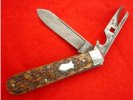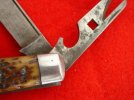You are using an out of date browser. It may not display this or other websites correctly.
You should upgrade or use an alternative browser.
You should upgrade or use an alternative browser.
wondering what this knife is?
- Thread starter delmas2nd
- Start date
- Joined
- Oct 28, 2006
- Messages
- 5,974
The knife is an S2393, a two blade jack with a cap-lifter and can opener secondary.

Here is a chart of Schrade Cut Co blades and their functions. Nothing is mentioned about that square cut-out, but I thought I remembered someone mentioning an automotive repair/adjustment function for that?


Here is a chart of Schrade Cut Co blades and their functions. Nothing is mentioned about that square cut-out, but I thought I remembered someone mentioning an automotive repair/adjustment function for that?

Last edited:
- Joined
- Oct 30, 2010
- Messages
- 2,092
Nice pocket knife you have. 
-Bruce
I guess that dates this knife quite early? When did cars have gas headlights? Early 1900's?I believe it was a wrench to adjust the flame of the prestolite gas headlights on cars.
-Bruce
Codger_64
Moderator
- Joined
- Oct 8, 2004
- Messages
- 61,818
Most makes of U.S. autos had electric lights by 1913-15. Before that they were gas... small tanks were mounted that held calcium carbide and water was dripped into them to produce acetelyne gas.
1913 Buick with Prestolite tank.

This would be the aproximate time when Sears was using the Wilbert name on knives so you might find the Prestolite key on "automobile knives" so marked.
ETA: Prestolite key knives were made into the 1920's, perhaps early 30's. The earlier cars didn't go away when the newer models came out. Look at the #9033 automobile knife in the 1926 SCC catalog.
http://collectors-of-schrades-r.us/Catalogs/images/1926_Schrade_Catalogs.pdf
1913 Buick with Prestolite tank.

This would be the aproximate time when Sears was using the Wilbert name on knives so you might find the Prestolite key on "automobile knives" so marked.
ETA: Prestolite key knives were made into the 1920's, perhaps early 30's. The earlier cars didn't go away when the newer models came out. Look at the #9033 automobile knife in the 1926 SCC catalog.
http://collectors-of-schrades-r.us/Catalogs/images/1926_Schrade_Catalogs.pdf
Last edited:
tongueriver
Gold Member
- Joined
- Dec 28, 2007
- Messages
- 4,911
Michael is correct on all counts. Notice that the tang stamp of the knife in question is not arched, suggesting that it post-dates WWI and perhaps the 1926 catalog, which shows no arched tang stamps. Watch this knife sell for an obscene amount of money (but not mine).
- Joined
- Oct 28, 2006
- Messages
- 5,974
I believe it was a wrench to adjust the flame of the prestolite gas headlights on cars.

To light the lamp, the valve on the tank was opened using the "key" (it was a square shank on the valve) by one person, and another person held a match at the lamp, and warned "stand back!" I don't have the start date for Prest-O-Lite (I'm thinking circa 1885), but they existed on the cars until circa 1915, then quickly phased out. Sometimes the caplifters had two different sized square holes, so the Prest-O-Lite system must have made two different sized tanks/valves. I would suspect that bicycle tanks would be smaller than car tanks.

Carriage Key - A simple key used to operate the secondary locks fitted to coach doors and some other access panels on locomotives and rolling stock. In addition to the carriage key and knife, this tool has a Prest-O-Lite Key* for opening cylinders to turn on gas lamps.
Dave Thinkstoomuch
BANNED
- Joined
- Jun 15, 2009
- Messages
- 1,196
this is what is so enjoyable about this forum and all the very nice and informative people that populate this place. the free sharing of knowledge and hey the knowledge. history comes alive if we let it.
Seconded. Prest-O-Lite wrench-blade? Learn something new all the time...
tongueriver
Gold Member
- Joined
- Dec 28, 2007
- Messages
- 4,911

The earliest headlight technology was essentially a lantern with a reflecting mirror. This focused the light source though an opening in the lantern, but because there were no effective headlight lenses at this time, the beam was fairly unfocused and there was significant scattering of the light upwards as glare. This, combined with the low-candlepower light sources of the time, meant that they were a weak, low-speed-only means of illumination – unfocused and with poor range. Plus, a good gust of wind or a wayward splash of water could snuff the flame. The fuel was usually oil, or the more weather-resistant acetylene. Acetylene lamps were also known as carbide lamps, and had been developed for mining. Gas was produced by dripping water on calcium carbide, which produced the acetylene gas, which was then burnt in the lamp. However, the flame was sooty and the byproduct was caustic lime, a toxic substance that had to be disposed of.
- Joined
- Oct 30, 2010
- Messages
- 2,092
Thanks for posting this. I have never seen one lit before. I now have a better idea of what those old timers had to deal with in the way of head lamps.
The earliest headlight technology was essentially a lantern with a reflecting mirror. This focused the light source though an opening in the lantern, but because there were no effective headlight lenses at this time, the beam was fairly unfocused and there was significant scattering of the light upwards as glare. This, combined with the low-candlepower light sources of the time, meant that they were a weak, low-speed-only means of illumination
-Bruce
- Joined
- Apr 14, 2008
- Messages
- 1,071
not sure but this knife is not up for bid but buy it now. was wondering is it real? as in Schrade USA, Ellenville?
http://www.ebay.com/itm/Made-in-USA...229?pt=Collectible_Knives&hash=item4ab287c93d
http://www.ebay.com/itm/Made-in-USA...229?pt=Collectible_Knives&hash=item4ab287c93d


